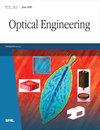复杂矢量涡束的纹理分类
IF 1.2
4区 工程技术
Q4 OPTICS
引用次数: 0
摘要
摘要与复杂矢量涡束(VVB)相关的横向空间结构是通过图像纹理方法进行分类的,该方法基于从方位敏感灰度级共现矩阵(a-GLCM)中提取的 Haralick 特征。此前,所提出的纹理识别器已在方位对称数字图像上进行了测试,与传统的 GLCM 相比有了改进。然后,考虑到其合适的空间对称性,用数值方法生成了拉盖尔-高斯模式矢量梁,以描述其横截面的特征。然而,由于结构信息复杂,VVB 被解耦为三个 8 位灰度图像(通道),分别对应强度、方向和椭圆度参数。计算每个通道的 a-GLCM 和 Haralick 特征,目的是量化作为拓扑电荷函数的横向结构演变。此外,还研究了图像缩放效应,以测试该方法的鲁棒性。基于 a-GLCM 的纹理分析虽然简单,但却为 VVB 结构的分类提供了启示。本文章由计算机程序翻译,如有差异,请以英文原文为准。
Texture classification of complex vector vortex beams
Abstract. Transverse spatial structure associated to complex vector vortex beams (VVBs) is classified through an image texture approach, which is based on Haralick features derived from an azimuthally sensitive gray-level co-occurrence matrix (a-GLCM). Previously, the proposed texture identifier has been tested on azimuthally symmetric digital images presenting an improvement in comparison with conventionally constructed GLCM. Then, considering their suitable spatial symmetry, Laguerre–Gauss mode vector beams were numerically generated to characterize its transverse section. Nonetheless, because of the complex structural information, VVBs are decoupled in three 8-bit grayscale images (channels) corresponding to intensity, orientation, and ellipticity parameters. a-GLCMs and Haralick features for each channel are computed with the aim of quantifying transverse structure evolution as a function of topological charge. Also, image scaling effects are studied to test the approach robustness. Even though it has simplicity, texture analysis based on a-GLCM provides an insight to classify VVB structure.
求助全文
通过发布文献求助,成功后即可免费获取论文全文。
去求助
来源期刊

Optical Engineering
工程技术-光学
CiteScore
2.70
自引率
7.70%
发文量
393
审稿时长
2.6 months
期刊介绍:
Optical Engineering publishes peer-reviewed papers reporting on research and development in optical science and engineering and the practical applications of known optical science, engineering, and technology.
 求助内容:
求助内容: 应助结果提醒方式:
应助结果提醒方式:


